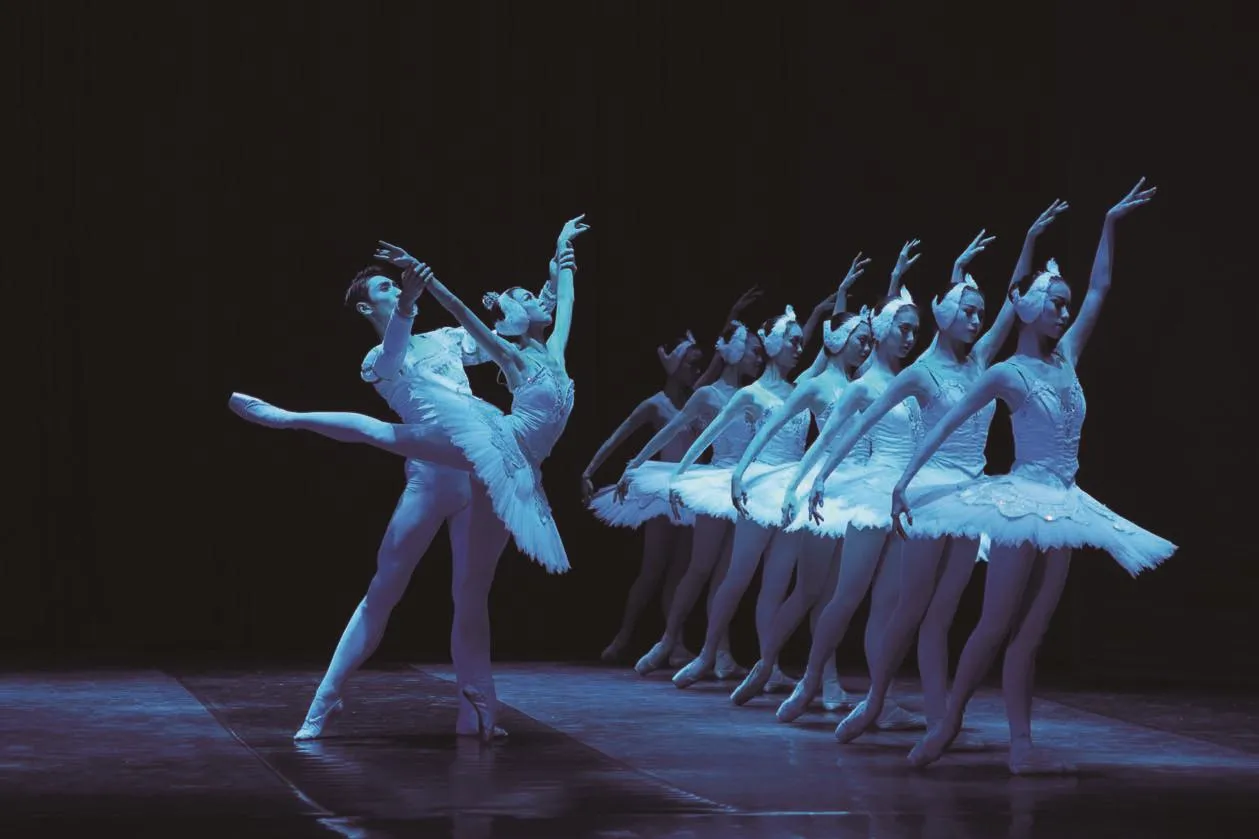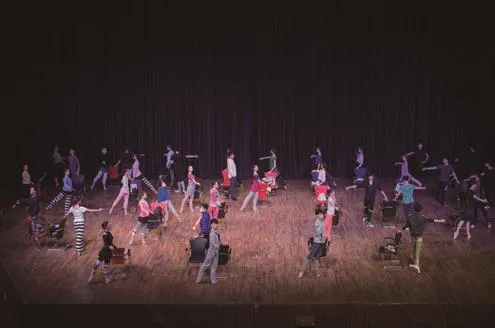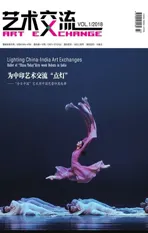中印舞蹈家的共舞之旅
2018-07-05鲁克米妮查特吉印度RukminiChatterjee
文鲁克米妮·查特吉(印度)Rukmini Chatterjee

《天鹅湖》剧照 Stills of Swan Lake
2月的德里已是冬天,傍晚分外凉爽,当地人陆续成群结队地来到西里堡剧场,观看广州芭蕾舞团的演出。该演出是“今日中国”艺术周的一个重要板块。演出开始前半小时我就到了剧场,原本以为自己会是第一批抵达的观众,可令我非常惊讶的是,剧场大厅几乎全被热情的观众占据,因为我们印度观众很少有机会在这里看到中国舞蹈团的演出。大厅里的观众们都满怀期待,这种期待不断在人们的心中累积,直到舞台大幕升起。
美丽的中国舞者们以《天鹅湖》第二幕的第一章节开场,他们镇定自若的表演和娴熟的艺术技巧深深吸引着观众。或许因为我自己就是舞蹈编导兼舞者,我也注意到了什么——没错,我发现舞台的木地板上居然没有铺设芭蕾必须的地胶!因此,中国舞蹈家们的专业精神、高超的技巧以及在没有地胶情况下所展现的精湛技艺都给我留下了分外深刻的印象。之后的《古典大双人舞》、中国芭蕾《舞越潇湘》和爵士芭蕾《千头万绪》等节目又让观众们领略了该舞团擅长驾驭的艺术审美和多样的舞蹈风格。对我而言,法国人最推崇的“重头戏”(pièce de résistance)是下半场的中国交响芭蕾舞剧《梁祝》。这不仅是一个动人的爱情故事,同时也以鲜明的风格和强烈的情感让印度观众一睹中国古典舞的风采。伴奏的音乐无疑也带来了更美好的欣赏体验。相信许多观众也有我同样的感受,因为演出后现场响起了雷鸣般的掌声。
我不禁回想起北京舞蹈学院和其开设的中国古典舞训练课程。2017年11月,北舞毕业汇报演出的那一天,我在学院里亲眼领略了这种舞蹈风格。那一天学生们首先要进行表演中国古典舞必要的练功,之后逐渐展示这种舞蹈不同的编排效果。我不仅为舞者和他们的刻苦训练所倾倒,而且这种舞蹈形态激发了我更多奇妙的灵感。那一天,我体会到印地语中所说的“Nriita”(纯舞蹈动作)、“Nritya”(情感与情绪)以及“Natya”(叙事方式),都在这种舞蹈形式中和谐地结合在一起。我非常希望在印度的舞者们也能学习中国古典舞,因为在我看来,他们接受这种舞蹈训练有助于丰富他们自己的舞蹈风格。
说到舞蹈合作,就不得不提及《贝玛·莲》,一部将中国现代舞和印度古典舞相结合的中印联合编创舞剧,2017年11月在北京首演。《贝玛·莲》是一个简单却感人的爱情故事,主要演员共10人,其中3位是印度的女舞者,7位是中国的男舞者。他们的表演带领人们探索欲望、激情、嫉妒、愤怒、爱情和最终融合的不同侧面。中印两大古代文明有许多共同之处,这些共同点在这场表演中被推向极致,这也是对人类共性的一种追求。两种文明都以各自的方式寻求平衡与和谐,而这恰恰是《贝玛·莲》的主旨。
自《贝玛·莲》在北京首演后,在中国和印度不断被看过的观众接受和赞赏。对于我、北京城市当代舞蹈团团长滕爱民先生、中国舞协以及《贝玛·莲》的各位协作者、指导者和制作人来说,都是一份美妙的礼物和难忘的经历。中国舞协主席冯双白先生、驻会副主席罗斌先生和外联部的张秋珑女士不仅从初期设想时就对这一合作项目充满信心,而且在整个创作过程中一直热心参与,并主动促成我们的合作,帮助我们实现了这一创作。
2016年11月,我第一次在德里欣赏到北京城市当代舞蹈团的演出。当时我的直觉立刻确信,我们可以一起创作出美妙的作品。演出当晚,我就向他们大胆提议合作编创,中国舞协和滕爱民先生也对我的建议也积极回应。这个想法也得到了印度斯里拉姆表演艺术中心的支持。就这样,《贝玛·莲》应运而生。
2016年至2017年间,我们几度会面,一直就这一复杂的艺术编创过程中艺术以及现实的方方面面共同努力,包括许多次集思广益的头脑风暴。最终在2017年11月,我们把中印两国所有的舞者聚集在北京排练了五个星期,将我们的梦想变成现实。
当然,在创作过程中的各个时期,我们的工作方式也不尽相同。无论是艺术背景还是创作理念上,滕爱民先生和我也存在差异。但是,我们真诚地团结在一起,创造出具有世界性意义的作品这一强烈的共同愿望使我们更加包容地看待彼此之间的差异,并促使我们发挥各自的长处。对我来说,这也是一次很好的学习经历。
我希望在不久的将来类似这样两国艺术家之间交流合作的项目可以越来越多,可以增加彼此的相互理解和尊重,又会为我们创造一个更加和谐的生活环境,这才是我们这个时代必不可少的要素。
On a cold winter evening Delhiites came in large numbers to the Siri Fort Audi torium to see the Guangzhou Ballet perform. This was part of the “Today China”Arts Week. I arrived half an hour before the performance thinking I would be amongst the first. To my great surprise the hall was almost full. It is rare that we Indian audiences get to see Chinese dance companies perform here. There was a sense of expectation in the hall and it kept building up until the curtain went up.
Beautiful dancers graced the stage for the first piece ofSwan LakeAct 2. They charmed the audience with their poise and skilfulness. But what also grabbed my attention, maybe because I am a choreographer and dancer, is that there was no dance carpet to cover the wooden stage floor! Therefore I was doubly impressed with the dancers, their professionalism,their technique their mastery in doing without it. A grand pas de deux followed by Chinese balletNatural Melodyand jazz balletMoody Moves, gave the audience a taste of the artistry and the multiplicity of dance styles the company is capable of. For me the pièce de résistance was the Chinese symphony balletButterfly Lovers. Not only was it a moving love story, but it also gave the Indian audience a glimpse of classical Chinese dance, with its powerful style and emotions. The accompanying music enhanced the experience. Many in the audience probably felt the same way because the applause after this piece was thunderous.
This takes me back to the Beijing Dance Academy and its classical Chinese dance training program. I witnessed this style for half a day last November at the Academy, the day they presented their last-year students to the public. The day started with body training required to perform this dance form and little by little the program showcased the different choreographic possibilities of this dance style. I was mesmerized not just by the dancers and their training,but also by the fantastic impressions that this dance style evoked in me. I felt that day that, “Nriita”, pure dance movements,“Nritya”, sentiments and moods, and “Natya”, the way in which a story is told, all came together very harmoniously in this form. I would very much like Chinese classical dance to be taught in India because I think our dancers could hugely enrich their own styles if they were given this body training.
Talking about dance collaborations, here I would like to mentionShiv Yin, the performance that brought contemporary Chinese dance and Indian classical dance together on the same stage last November in Beijing.Shiv Yinis a simple yet touching love story where the protagonists, 10 in all, 3 female Indian classical dancers and 7 male Chinese contemporary dancers, take us on a journey exploring the different facets of desire, passion, jealousy, anger,love and finally ultimate union. These two ancient civilizations have a lot in common and these commonalities are brought to the forefront in this performance. It is a quest for the universal in Man. Both these civilizations in their own ways have always been searching for balance and harmony and these aspects are a leitmotif ofShiv Yin.
Since its première in Beijing it has been performed to receptive and appreciative audiences in both China and India. This has been a wonderful gift and experience for me, Mr TENG Aimin and the China Dancers Association, the artistic directors, co-coreographers and producers ofShiv Yin. Mr Shuangbai Feng, Mr Bin Luo and Ms Qiulong Zhang from the CDA not only believed in this project from the word go, but were instrumental in making it happen by being very present during the whole creative process and by positively reinforcing all the strengths of this collaboration.
I saw the Beijing City Contemporary Dance Company perform in Delhi in November 2016 and I was intuitively and immediately convinced that together we could create something wonderful.The CDA and Mr. TENG Aimin both reacted very positively to my proposition of doing a collaborative work, as soon as I mentioned it to them that same evening after the performance. The idea was also very well received in India by the Shri Ram Center for Performing Arts, Delhi, and thereforeShiv Yinwas born.
We all met up a few times during the year 2016/2017 to work on the artistic and practical aspects of putting this complex production together. There were many brainstorming sessions.Then in November 2017 we brought all the Chinese and Indian dancers together in Beijing for five weeks to make our dream become reality.
Of course, there were differences in our approach to the work at different times during the creative process. Mr. TENG Aimin and I come from very different backgrounds artistically and mentally.But our profound desire of truly coming together and creating something meaningful for audiences around the world, made us see our differences in a more balanced manner and made us emphasize our common strengths. It has been a great learning experience for me.
I hope many more people-to-people projects happen in the near future so that our understanding and respect for each other increases and that this in turn creates a more harmonious environment for us to live in, a great necessity for our times.

广州芭蕾舞团演员在排练中Performers of Guangzhou Ballet in Rehearsal
